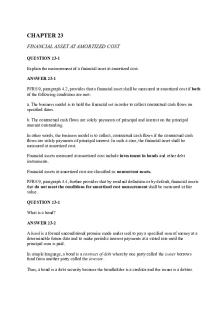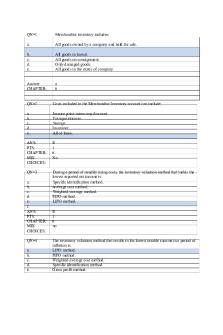Module 7 - Measurement AT Other THAN COST PDF

| Title | Module 7 - Measurement AT Other THAN COST |
|---|---|
| Course | Advance Accounting |
| Institution | New Era University |
| Pages | 36 |
| File Size | 4.6 MB |
| File Type | |
| Total Downloads | 424 |
| Total Views | 767 |
Summary
1. Introduction/OverviewThis module aims to provide students a comprehensive understanding and application of the proper accounting principles for the preparation of consolidated financial statements wherein the investment in subsidiary account is measured at other than cost and preparation of conso...
Description
1. Introduction/Overview This module aims to provide students a comprehensive understanding and application of the proper accounting principles for the preparation of consolidated financial statements wherein the investment in subsidiary account is measured at other than cost and preparation of consolidated financial statements of a complex group structure. 2. Learning Outcomes a.
b.
Prepare the consolidated financial statements wherein the investment in subsidiary account is measured at other than cost. Prepare the consolidated financial statements of a complex group structure.
3. Investment in subsidiary measured at other than cost Initial measurement of investment in subsidiary account: •
Equal to the value assigned to the consideration transferred at the acquisition date
Subsequent measurement either at: a.
At cost;
b.
In accordance with PFRS 9 Financial Instruments; or
c.
Using the equity method • • •
Investment is initially measured at cost Subsequently adjusted for changes in the equity of the investee and depreciation of any undervaluation or overvaluation Dividends received from the investee are recognized as deduction to the carrying amount of the investment
4. Complex group structure Complex group structure • • •
A.
Related entities may have overlapping interests in each other Arises when parent obtains control over another entity indirectly through its direct holdings over another entity It is either vertical group or D-shaped (mixed) group
Vertical group •
B.
Parent’s subsidiary has its own subsidiary (sub-subsidiary)
D-shaped (mixed) group •
parent has a direct controlling interest in at least one subsidiary, and in addition, both the parent and the subsidiary together hold a controlling interest in another entity
Identifying the acquisition date • • •
Date the acquirer obtains control of the acquiree It is the date the sub-subsidiary becomes a member of the parent group Goodwill from each subsidiary and sub-subsidiary are computed separately on their respective acquisition dates
4.1. Consolidation of a vertical group • •
Parent is required to consolidate all entities it controls whether direct or indirect holdings In the previous example, there are two groups, the parent group and the subsidiary 1 group.
4.2. Consolidation of D-shaped (mixed) group • •
Consolidation is similar to vertical group The parent holds both a direct and indirect interest in a sub-subsidiary
4.3. Complex group structure with associate •
Investments in associates are accounted using the equity method, “one-line consolidation”
5. Push-down accounting • • •
Another approach of assigning fair value adjustments (FVA) to a subsidiary’s net identifiable assets FVA are directly recorded in the subsidiary’s books. FVA are pushed down to subsidiary’s statements.
Authoritative status of push-down accounting The SEC in the US 1.
Requires push-down accounting •
2.
Encourages push-down accounting • •
3.
If a subsidiary is “substantially wholly-owned” (95% above)
If a parent’s ownership interest is 80% to less than 95% If subsidiary has outstanding public debt or preference share
Prohibits push-down accounting If parent’s ownership is less than 80%
PFRSs do not address push-down accounting. Neither does the Philippine SEC require the use of the pushdown accounting. Arguments on the use of push-down accounting Proponents’ view Substantial change in ownership creates a new basis of accounting for the subsidiary’s assets and liabilities • Subsidiary’s financial statements are viewed as extension of the parent’s statements (parent company theory) • Basis of accounting for the subsidiary’s net identifiable assets should be parallel the parent’s accounting basis for newly purchased assets and liabilities, at fair values •
Oppositions’ view New basis of accounting should not arise irrespective of the ownership change in a subsidiary Subsidiary’s financial statements are viewed as a distinct part of a group (entity theory) Subsidiary should still retain its previous accounting basis for its net identifiable assets in its separate financial statements Subsidiary did not actually sell anything, a new basis of accounting should not arise. Thus, acquisition-date fair values adjustments should be reflected only in the consolidated financial statements but not in the subsidiary’s separate financial statements...
Similar Free PDFs

Investment at Amortized Cost
- 5 Pages

Production at least cost
- 2 Pages

Financial Asset AT Amortized COST
- 10 Pages

7 Measurement AND DATA Collection
- 10 Pages

Strategic Cost Chap 7
- 50 Pages

Pagbasa at Pagsusuri - Module 1
- 33 Pages
Popular Institutions
- Tinajero National High School - Annex
- Politeknik Caltex Riau
- Yokohama City University
- SGT University
- University of Al-Qadisiyah
- Divine Word College of Vigan
- Techniek College Rotterdam
- Universidade de Santiago
- Universiti Teknologi MARA Cawangan Johor Kampus Pasir Gudang
- Poltekkes Kemenkes Yogyakarta
- Baguio City National High School
- Colegio san marcos
- preparatoria uno
- Centro de Bachillerato Tecnológico Industrial y de Servicios No. 107
- Dalian Maritime University
- Quang Trung Secondary School
- Colegio Tecnológico en Informática
- Corporación Regional de Educación Superior
- Grupo CEDVA
- Dar Al Uloom University
- Centro de Estudios Preuniversitarios de la Universidad Nacional de Ingeniería
- 上智大学
- Aakash International School, Nuna Majara
- San Felipe Neri Catholic School
- Kang Chiao International School - New Taipei City
- Misamis Occidental National High School
- Institución Educativa Escuela Normal Juan Ladrilleros
- Kolehiyo ng Pantukan
- Batanes State College
- Instituto Continental
- Sekolah Menengah Kejuruan Kesehatan Kaltara (Tarakan)
- Colegio de La Inmaculada Concepcion - Cebu









